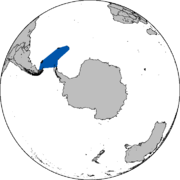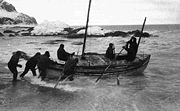
Scotia Sea
Encyclopedia


Southern Ocean
The Southern Ocean comprises the southernmost waters of the World Ocean, generally taken to be south of 60°S latitude and encircling Antarctica. It is usually regarded as the fourth-largest of the five principal oceanic divisions...
and mostly in the South Atlantic Ocean.
Location and description
Habitually stormy and cold, the Scotia Sea is the area of water between Tierra del FuegoTierra del Fuego
Tierra del Fuego is an archipelago off the southernmost tip of the South American mainland, across the Strait of Magellan. The archipelago consists of a main island Isla Grande de Tierra del Fuego divided between Chile and Argentina with an area of , and a group of smaller islands including Cape...
, South Georgia, South Sandwich Islands, South Orkney Islands
South Orkney Islands
The South Orkney Islands are a group of islands in the Southern Ocean, about north-east of the tip of the Antarctic Peninsula. They have a total area of about ....
and the Antarctic Peninsula
Antarctic Peninsula
The Antarctic Peninsula is the northernmost part of the mainland of Antarctica. It extends from a line between Cape Adams and a point on the mainland south of Eklund Islands....
, and bordered on the west by Drake Passage
Drake Passage
The Drake Passage or Mar de Hoces—Sea of Hoces—is the body of water between the southern tip of South America at Cape Horn, Chile and the South Shetland Islands of Antarctica...
. These island groups all sit on top of the Scotia Ridge, which frames the Scotia Sea north, east, and south. The Scotia Sea covers an area of about 900,000 km². About half of the sea stands above the continental shelf
Continental shelf
The continental shelf is the extended perimeter of each continent and associated coastal plain. Much of the shelf was exposed during glacial periods, but is now submerged under relatively shallow seas and gulfs, and was similarly submerged during other interglacial periods. The continental margin,...
.
The islands are rocky and partly covered in ice and snow the year round.
History
Named in about 1932 after the Scotia, the expedition ship used in these waters by the Scottish National Antarctic Expedition (1902–04) under William S. Bruce. The most famous traverse of this frigid sea was made in 1916 by Sir Ernest ShackletonErnest Shackleton
Sir Ernest Henry Shackleton, CVO, OBE was a notable explorer from County Kildare, Ireland, who was one of the principal figures of the period known as the Heroic Age of Antarctic Exploration...
and four others in the adapted lifeboat James Caird when they left Elephant Island and reached South Georgia two weeks later.
In Argentina
Argentina
Argentina , officially the Argentine Republic , is the second largest country in South America by land area, after Brazil. It is constituted as a federation of 23 provinces and an autonomous city, Buenos Aires...
, the Scotia Sea is considered part of the Argentine Sea
Argentine Sea
thumb|150px|Argentine Sea, off the [[Atlantic Ocean|atlantic]] coast of ArgentinaThe Argentine Sea refers to the sea within the continental shelf off the Argentine mainland...
(Spanish
Spanish language
Spanish , also known as Castilian , is a Romance language in the Ibero-Romance group that evolved from several languages and dialects in central-northern Iberia around the 9th century and gradually spread with the expansion of the Kingdom of Castile into central and southern Iberia during the...
Mar Argentino), and many of the territories claimed by Argentina such as South Georgia and the Falkland Islands, lie within this region.
On 20 August 2006 an earthquake with a magnitude of 7.0 struck at 1:41 a.m. local time (0341 GMT). The exact location was 61.011°S, 34.375°W at a depth of 10 km (6.2 mi) with a USGS event ID of "usrqal".
Flora and fauna
Despite the harsh conditions the islands do support vegetation and have been described as the Scotia Sea Islands tundra ecoregionEcoregion
An ecoregion , sometimes called a bioregion, is an ecologically and geographically defined area that is smaller than an ecozone and larger than an ecosystem. Ecoregions cover relatively large areas of land or water, and contain characteristic, geographically distinct assemblages of natural...
, which includes South Georgia, the volcanic South Sandwich Islands and the South Orkneys in the Scotia Sea as well as the remote South Shetland Islands
South Shetland Islands
The South Shetland Islands are a group of Antarctic islands, lying about north of the Antarctic Peninsula, with a total area of . By the Antarctic Treaty of 1959, the Islands' sovereignty is neither recognized nor disputed by the signatories and they are free for use by any signatory for...
near the Antarctic Peninsula and the small isolated volcano Bouvet Island
Bouvet Island
Bouvet Island is an uninhabited Antarctic volcanic island in the South Atlantic Ocean, 2,525 km south-southwest of South Africa. It is a dependent territory of Norway and, lying north of 60°S latitude, is not subject to the Antarctic Treaty. The centre of the island is an ice-filled crater of an...
. All these islands lie in the cold seas below the Antarctic convergence
Antarctic Convergence
The Antarctic Convergence is a curve continuously encircling Antarctica where cold, northward-flowing Antarctic waters meet the relatively warmer waters of the subantarctic. Antarctic waters predominantly sink beneath subantarctic waters, while associated zones of mixing and upwelling create a zone...
. These areas support tundra
Tundra
In physical geography, tundra is a biome where the tree growth is hindered by low temperatures and short growing seasons. The term tundra comes through Russian тундра from the Kildin Sami word tūndâr "uplands," "treeless mountain tract." There are three types of tundra: Arctic tundra, alpine...
vegetation consisting of moss
Moss
Mosses are small, soft plants that are typically 1–10 cm tall, though some species are much larger. They commonly grow close together in clumps or mats in damp or shady locations. They do not have flowers or seeds, and their simple leaves cover the thin wiry stems...
es, lichen
Lichen
Lichens are composite organisms consisting of a symbiotic organism composed of a fungus with a photosynthetic partner , usually either a green alga or cyanobacterium...
and algae
Algae
Algae are a large and diverse group of simple, typically autotrophic organisms, ranging from unicellular to multicellular forms, such as the giant kelps that grow to 65 meters in length. They are photosynthetic like plants, and "simple" because their tissues are not organized into the many...
, while seabirds, penguins and seals feed in the surrounding waters.
Seabirds include four species of albatross: Black-browed Albatross (Diomedea melanophris), Grey-headed Albatross (Thalassarche chrysostoma), Light-mantled Albatross (Phoebetria palpebrata), and Wandering Albatross (Diomedea exulans). There are only five species of bird that remain on land on the islands, and these include two endemic species: a race of the Yellow-billed Pintail duck(Anas georgica) and South Georgia Pipit (Anthus antarcticus).
Penguin
Penguin
Penguins are a group of aquatic, flightless birds living almost exclusively in the southern hemisphere, especially in Antarctica. Highly adapted for life in the water, penguins have countershaded dark and white plumage, and their wings have become flippers...
species found here include large numbers of King Penguin
King Penguin
The King Penguin is the second largest species of penguin at about , second only to the Emperor Penguin. There are two subspecies—A. p. patagonicus and A. p...
s on South Georgia especially, as well as Chinstrap Penguin
Chinstrap Penguin
The Chinstrap Penguin is a species of penguin which is found in the South Sandwich Islands, Antarctica, the South Orkneys, South Shetland, South Georgia, Bouvet Island and Balleny...
, Macaroni Penguin
Macaroni Penguin
The Macaroni Penguin is a species of penguin found from the Subantarctic to the Antarctic Peninsula. One of six species of crested penguin, it is very closely related to the Royal Penguin, and some authorities consider the two to be a single species...
, Gentoo penguin
Gentoo penguin
The Gentoo Penguin , Pygoscelis papua, is easily recognized by the wide white stripe extending like a bonnet across the top of its head and its bright orange-red bill. The gentoo penguin has pale whitish-pink webbed feet and a fairly long tail - the most prominent tail of all penguins. Chicks have...
, Adelie Penguin
Adelie Penguin
The Adélie Penguin, Pygoscelis adeliae, is a species of penguin common along the entire Antarctic coast. They are among the most southerly distributed of all seabirds, as are the Emperor Penguin, the South Polar Skua, the Wilson's Storm Petrel, the Snow Petrel, and the Antarctic Petrel...
, and Rockhopper Penguin (Eudyptes chrysocome).
Seals include the Antarctic Fur Seal (Arctocephalus gazella) and Sub-Antarctic Fur Seal (Arctocephalus tropicalis) in large numbers, Leopard Seal
Leopard Seal
The leopard seal , also referred to as the sea leopard, is the second largest species of seal in the Antarctic...
(Hydrurga leptonyx), Weddell Seal
Weddell Seal
The Weddell seal , is a relatively large and abundant true seal with a circumpolar distribution surrounding Antarctica. Weddell seals have the most southerly distribution of any mammal, with a habitat that extends as far south as McMurdo Sound...
(Leptonychotes weddellii), the huge Southern Elephant Seal
Southern Elephant Seal
The Southern Elephant Seal is one of the two extant species of elephant seal. It is both the most massive pinniped and member of the order Carnivora living today...
(Mirounga leonina), and Crabeater Seal
Crabeater Seal
The crabeater seal, Lobodon carcinophagus, is a true seal with a circumpolar distribution around the coast of Antarctica. They are medium to large-sized , relatively slender and pale-colored, found primarily on the free floating pack ice that extends seasonally out from the Antarctic coast, which...
(Lobodon carcinophagus).
Threats and preservation
Although the islands have a harsh climate and have never been permanently occupied they have long been used as a base for fishing and seal-hunting. Wildlife on these remote islands is threatened by introduced speciesIntroduced species
An introduced species — or neozoon, alien, exotic, non-indigenous, or non-native species, or simply an introduction, is a species living outside its indigenous or native distributional range, and has arrived in an ecosystem or plant community by human activity, either deliberate or accidental...
, especially on South Georgia, where even large animals including reindeer
Reindeer
The reindeer , also known as the caribou in North America, is a deer from the Arctic and Subarctic, including both resident and migratory populations. While overall widespread and numerous, some of its subspecies are rare and one has already gone extinct.Reindeer vary considerably in color and size...
have been brought to the islands. Further damage to ecosystems results from overfishing. South Georgia, the South Sandwich Islands and Bouvet Island are protected as nature reserves, with Bird Island, South Georgia being a site of special scientific interest
Site of Special Scientific Interest
A Site of Special Scientific Interest is a conservation designation denoting a protected area in the United Kingdom. SSSIs are the basic building block of site-based nature conservation legislation and most other legal nature/geological conservation designations in Great Britain are based upon...
. The seals are further protected by international agreements and Fur Seal populations are recovering.

